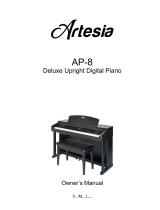
6
TABLE OF CONTENTS
ASSEMBLY .................................................................7
CONNECTOR PANEL ............................................... 16
Video Output........................................................... 16
Headphone Input ..................................................... 16
Audio In & Out ........................................................ 16
MIDI Jacks .............................................................. 16
USB........................................................................ 16
Microphone Input .................................................... 16
PANEL CONTROLS................................................... 17
DISK DRIVE ..............................................................28
PEDALS .................................................................... 29
DISPLAY SCREEN .................................................... 30
DEMO ........................................................................31
PIANO VOICES ......................................................... 32
Assigning a Mode ................................................... 32
Voice Selection ....................................................... 33
Quick Select........................................................... 34
RHYTHM SECTION ................................................... 37
Rhythm Style Select ............................................... 37
Quick Select........................................................... 37
Starting and Stopping the Rhythm Style .................. 40
Fill-In....................................................................... 40
Ending .................................................................... 40
Fade ....................................................................... 41
Adjusting the Tempo ...............................................41
AUTO ACCOMP. (AUTO BASE CHORD) ................... 42
One Finger .............................................................. 43
Fingered.................................................................. 44
Piano ...................................................................... 45
Manual Bass Chord ................................................ 45
Selecting Chord Type .............................................. 46
Starting and Stopping the Auto Accomp. .................47
Fill-In....................................................................... 48
Fill to Variation ........................................................ 48
Fade ....................................................................... 48
SETUP....................................................................... 49
Performance
Velocity ............................................................ 50
Split Point......................................................... 50
Transpose ........................................................ 51
Screen Hold ..................................................... 51
Tune ................................................................. 52
Fixed Level ....................................................... 52
Fade Time ........................................................ 53
Octave Shift ...................................................... 53
SETUP (Continued)
Harmony ................................................................. 54
Key Mode
Manual Bass .................................................... 55
Lower Hold ....................................................... 55
Sustain ................................................................... 56
Reverb .................................................................... 57
Effects .................................................................... 58
Chord (Auto Accompaniment Fingering) .................. 59
Pedal Menu ............................................................ 60
Percussion (Drum Kit Assign) ................................. 61
Metronome.............................................................. 62
REGISTRATION MEMORY ........................................ 63
RECORD .................................................................... 64
Recording ............................................................... 66
Playback ................................................................ 67
Mark ....................................................................... 68
SONG ........................................................................ 69
Song Select ............................................................ 69
Using the Lesson Feature ....................................... 70
DISK ........................................................................ 72
Load Song .............................................................. 73
Save Song .............................................................. 74
Play Disk ................................................................ 75
Utility
Format.............................................................. 77
Copy ................................................................ 77
Delete............................................................... 78
Rename............................................................ 78
PLAYING AND SINGING KARAOKE ......................... 79
MIDI & VIDEO OUTPUT .......................................... 80
MIDI ........................................................................ 81
MIDI IMPLEMENTATION CHART .............................. 83
VOICE LIST............................................................... 84
STYLE LIST ..............................................................85
DRUM KIT LIST 1 ..................................................... 86
DRUM KIT LIST 2 ..................................................... 87
SPECIFICATIONS ..................................................... 88
QUESTIONS / PROBLEMS ....................................... 89
WARRANTY............................................................... 91

























